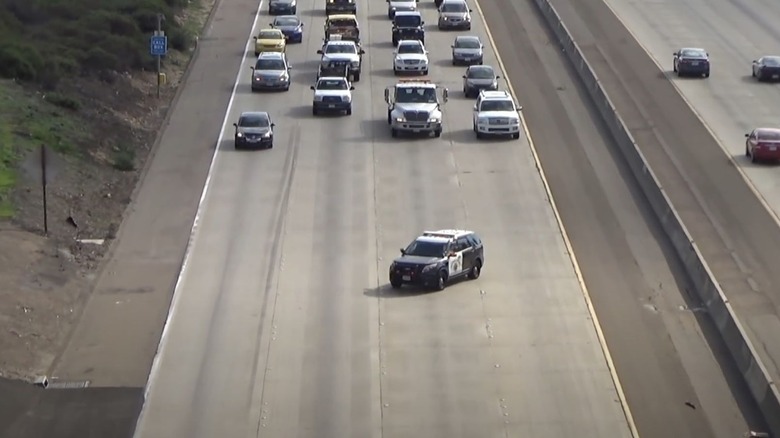The Reason Why Police Cars Swerve On The Freeway
Imagine that you're driving down your local highway (at the posted speed limit, of course) when you suddenly see a law enforcement vehicle ahead with its lights on, weaving back and forth in a serpentine zigzagging motion across all the lanes. In most cases, they're likely slowing down and may even come to a complete stop. No, they almost certainly aren't drunk, nor are they on a power trip.
This strategic technique is known as a traffic break. However, depending on your state, this maneuver can also be called a rolling roadblock, a slowdown, round robin, or some other local vernacular, but they all mean the same thing. The officer is attempting to slow down (or stop) the flow of highway traffic in a controlled manner because there is some kind of hazardous situation up ahead. Traffic breaks are only used when necessary and almost always in the service of driver safety.
For instance, a bad accident that obscured several lanes may have occurred, as was the case in Northern California in 2017 when a collision happened between a big rig hauling grapes and a truck towing a camper. Other scenarios may include road repairs, clearing congestion and managing traffic flow, or some unexpected debris that's fallen onto the road, requiring a cleanup crew to move. A traffic break might also be performed if an emergency police operation occurs on the roadway, such as a high-risk car stop. Excessive rain or fog might also call for a traffic break as well.
What you should do if you encounter a traffic break
When a traffic break is encountered, regardless of the reason, there are some rules you, as the driver, need to follow. First, activate your car's emergency blinkers to help warn other drivers behind you that something is going on ahead that requires caution. Second, slowly decrease your speed to match that of the swerving police vehicle and refrain from coming to an immediate stop, as that can cause a collision with cars behind you. Third, resist the urge to speed up and zoom past the police vehicle in some fruitless effort to "beat the traffic."
Your presence (wherever you're going) is not so desperately needed as to break the law, because it's illegal to jump a traffic break — doing so will ensure all you reap will be hefty consequences. Typically, the officer is performing a traffic break miles ahead of whatever hazardous condition exists, so you won't even see what you're driving into. Blindly driving headlong into an unknown situation can be dangerous.
Lastly, only accelerate to normal speed after the traffic break has ended, which usually happens when the officer turns off the emergency lights on the patrol car and either speeds up so fast as to pull far ahead of the traffic break or it simply moves off the roadway entirely. Then and only then is it safe to continue driving normally at posted speed limits.
